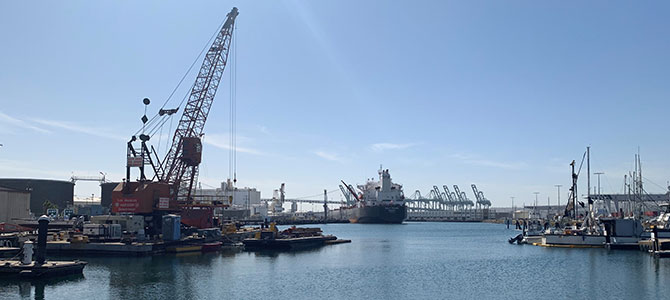Building a successful Environmental Management System (EMS) is a lot like loading a cargo ship. There are several moving parts that need to be accounted for and organized in a way that is both trackable and reportable. The Port of Los Angeles (POLA) approached
our firm for assistance with staffing and upgrading their EMS ISO 14001:2015. Instead of merely checking the necessary boxes, the project served as a prime example of a successful EMS approach that focused on identifying client problems and building
a system that accommodates for the port’s long-term environmental compliance and sustainability goals.

The Art of Multitasking
Just as a lot of careful planning needs to go into accounting for each crate on a cargo ship, implementation of an EMS has a lot of simultaneous moving parts for which we needed to plan. We led and facilitated the “Core Team” for the EMS that
was responsible for ongoing elements, including implementation and review of its environmental policy and guidelines. Our scope of work also included identifying significant environmental impacts and objectives, as well as tracking environmental management
programs. We also reviewed and drafted EMS procedures, provided gap analysis and updated the EMS manual with over 60 operational control documents used to help guide trade personnel. Additionally, we were responsible for multiple ongoing trainings
and extensive logistical elements.
To manage these tasks there were several factors for success:
- Using the EMS to target compliance and sustainability goals
- Establishing effective communication and collaboration with the cross-functional Core Team
- Reaching consensus decision-making with the Core Team
- Tracking metrics and reporting often

Helping to Carry the Load
At the time, POLA had been operating its EMS since 2007 and was due for an update. It had the same objectives and targets for years, so our team reinvigorated the system for both compliance and environmental initiatives. We created a system that was user-friendly
and accessible onsite for easy and effective day-to-day use.
Our project team wanted to go above and beyond, so we started looping in other issues that POLA was dealing with – such as hazardous waste – into the EMS. At the time, the port had several hazardous waste drums onsite that were over the 90-day
limit based on its “large quantity generator” status, so we created a new environmental objective. We drafted a plan under the EMS to deal with environmental compliance issue which allowed the internal audit team to look at the hazardous
waste data as they went through their daily checklist. Then, we used the EMS to help us comply with the regulations, perform inspections, update operational controls, and provide more training to the staff.
To stay on objective, we performed weekly inspections of the hazardous waste holding areas and wrote new operational controls that allowed the internal auditors to handle any changes or policy additions handed down from either the City of Los Angeles
or from the port commission.
A Model for Future Success
By identifying with the client’s challenges and using the EMS as a structure to fix some of those issues, we can expect more effective compliance. As a result of the project, we didn’t have any external or internal audit findings and were
able to establish better overall communication with employees on the port’s environmental goals as well as bridge the gaps on the level of communication between staff groups. While part of the end goal is ISO 14001:2015 certification, we ultimately
wanted to create a usable system that staff want to work with and want to use until their next update.
At the March Core Team meeting, I announced that it would be my last one. To my surprise, I received a standing ovation for the work we had achieved – a testament to a successful project and the strong working relationship we have established with
the port.